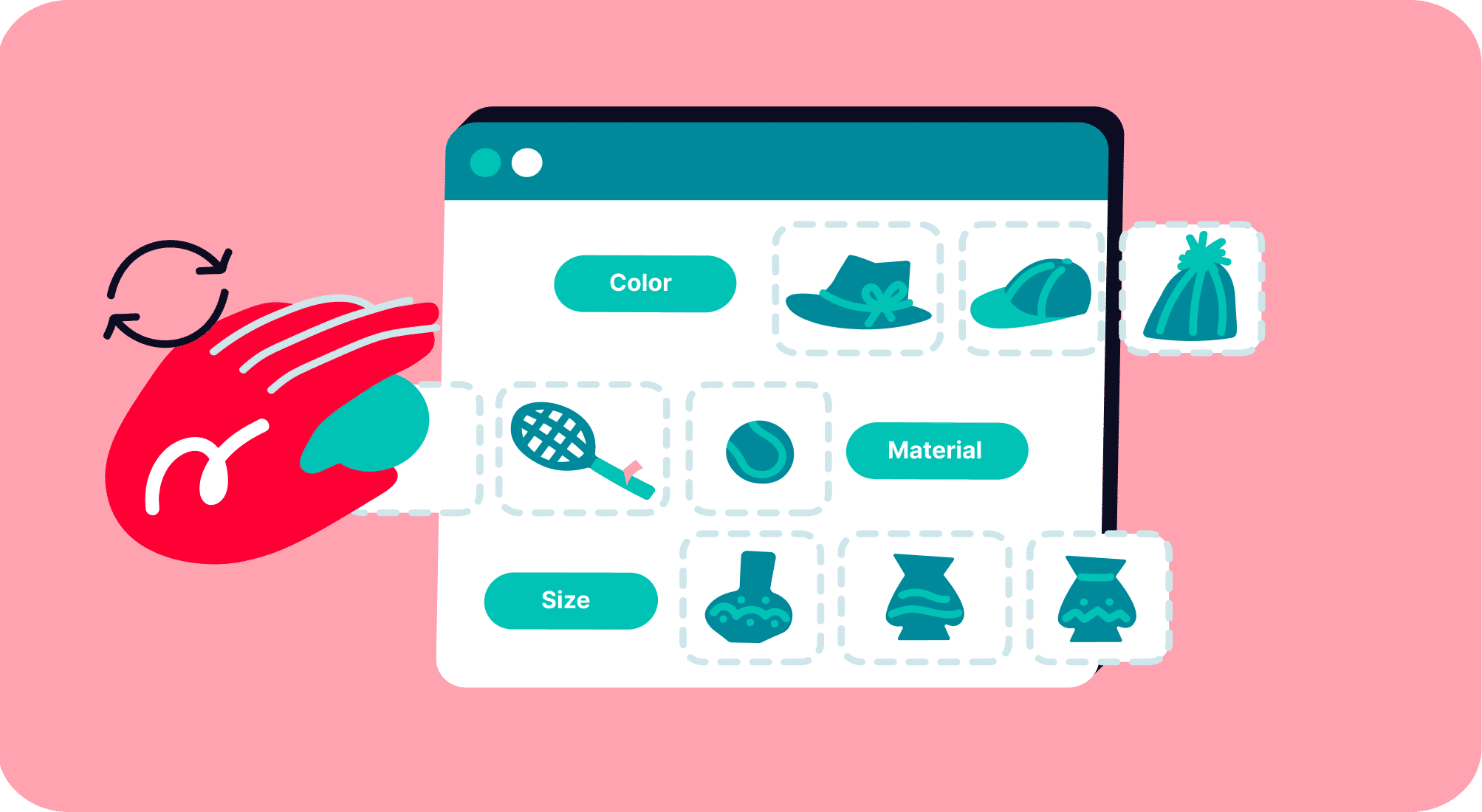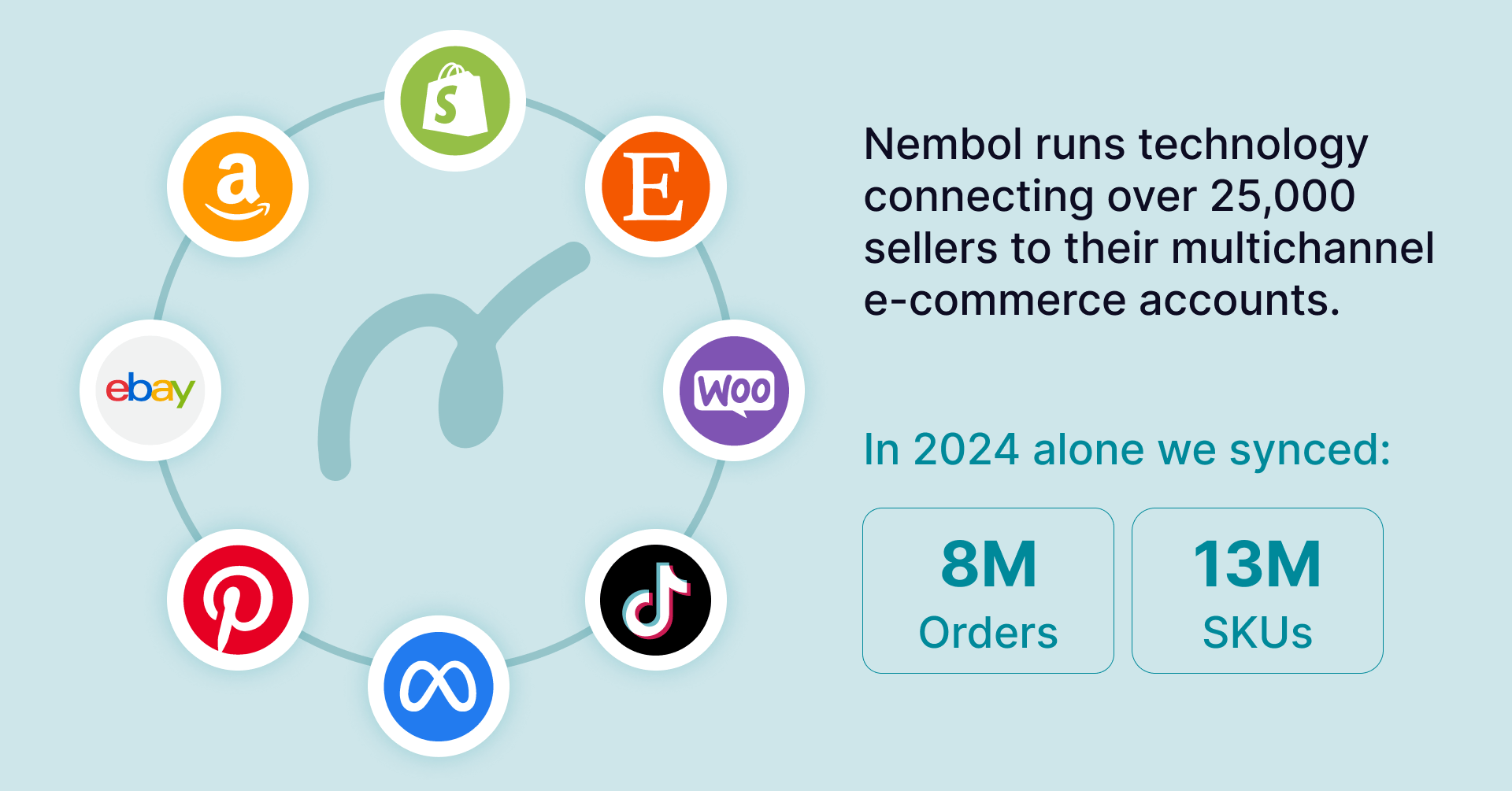Last update October 21, 2025
What are product variants?
Product variants refer to different versions of the same product that vary by attributes such as size, color, material, style, or more.
For example, a T-shirt available in small, medium, and large sizes, or in red, blue, and green colors, includes multiple variants under one product. Variants help sellers present multiple options to customers without creating separate listings for each version.
Why are variants important?
Variants are crucial for providing shoppers a seamless experience, giving them the ability to choose their preferred options quickly within a single product page.
They simplify inventory management by grouping all versions together, reducing duplicated data, and helping sellers accurately track stock levels per variant. Proper variant management can increase sales conversion by offering variety while maintaining organized product catalogs.
Difference between variants and variations
Though oftentimes used interchangeably, variants and variations refer to slightly different concepts:
- A variant is a single version of a product defined by specific attribute combinations (e.g., a red, size M T-shirt).
- A variation often refers to the entire set or grouping of variants linked to a product (e.g., all color and size combinations collectively).
Understanding this distinction helps in setting up and synchronizing product data correctly, especially when listing products on multiple platforms, which may use one or the other term.

How variants work on different channels
Each sales channel has its own way of managing variants, with specific rules and setup requirements that sellers need to understand for smooth multichannel selling.
Variable products and Variations in WooCommerce
WooCommerce handles product variants through a specific product type called “Variable Products in WooCommerce”. This product type lets you define one or more attributes—for example, size, color, or fabric—and then create combinations of these attributes to generate individual variants. Each variant represents a unique version of the product customers can select on the product page.
To create variants in WooCommerce, you first need to add global or custom attributes to the product and mark them as used for variations. After setting the attributes, you go to the Variations tab to manually add each variant or generate them automatically based on attribute combinations.
Each variant can have its own SKU, price, weight, dimensions, stock quantity—allowing for precise control over inventory and pricing. For example, a T-shirt could have variants for size Small, Medium, and Large, each with its own stock level and SKU.
A product which has variants in Nembol, either because created in Nembol or imported from eBay, Etsy, Shopify, Amazon, or TikTok Shop, will easily and correctly be listed in WooCommerce as a Variable Product with its correct Attributes and Variations.
Same, a product with Attributes, Variations and quantities in WooCommerce will become in Nembol a product with variants, ready to be listed on additional e-commerce channels
Variations on eBay
Ebay manages variants through a section in the product listing called “Variations”. Here eBay sellers can create Variation options, and their values, called “Attributes” in eBay. This allows grouping multiple versions of the same product (such as color, size, or model) into a single parent listing as seen by buyers on eBay sites.
Each variant can have its own SKU code, price, quantity, and unique identifiers. This system improves user experience by letting buyers choose the desired variant directly on the product page.
Also from and towards eBay, Nembol publishes and imports products with the correct set of variants, prices, SKU codes and barcodes. Nembol does not manage variant pictures at this time.
Variations on Etsy
On Etsy, product variants are called variations and these can differ in key details like price, quantity, SKUs, and even processing profiles.
When adding variations, Etsy now presents options to specify which attributes vary between versions, including:
- Prices vary: Set individual prices for each variation option.
- Quantities vary: Manage stock levels per variation.
- SKUs vary: Assign unique SKUs to each variation.
- Processing profiles vary: assign different fulfillment or processing workflows to specific variations.
All e-commerce channels other than Etsy, impose that quantity and SKU codes vary per SKU, i.e. vary per variant. This is a requirement if you are an Etsy seller and will want one day to perhaps go multichannel. Read more below about this Etsy unique feature.
Variants on Shopify
Shopify enables you to manage products that come in multiple configurations by creating variants based on up to three selectable options, such as size, color, or material.
When setting up a product, you define these options and enter their possible values—for example, “Small,” “Medium,” and “Large” for size, and “Red” and “Yellow” for color. Shopify then automatically generates all the valid combinations of these values, each representing a distinct variant.
Each variant functions as an individual version of the product, with its own SKU, price, inventory level, weight, and barcode. Shopify limits each product to a maximum of 100 variants spread across up to 3 options. This limit is maintained in Nembol as well.
Variations on Amazon
Amazon manages product variations through a system known as parent-child relationships, where related product versions are grouped under a single parent listing. Each child listing represents a unique variant distinguished by attributes like size, color, flavor, or style. For example, a tank top available in multiple sizes and colors would have a parent listing encompassing all variations, with each size-color combination appearing as a separate child ASIN (Amazon Standard Identification Number).
The parent listing itself is not buyable and does not have individual pricing or stock; instead, it holds shared attributes common across all variations. Buyers select their desired option on the product page, enhancing the shopping experience by consolidating similar products.
Amazon requires that all variations under one parent share the same variation theme appropriate for the category, such as size or color. Misusing variation themes or combining unrelated products violates Amazon policies and can result in listing suppression. Each child ASIN must have unique identifiers like SKU and price.
Nembol will create two independent listings on your Amazon account. You can later merge these into a single listing through your Amazon Seller Central.
Variations on TikTok
TikTok Shop allows sellers to create product listings with multiple variations by enabling “Choose variation type” option in Seller Center. Sellers specify different options such as size, color, or type, and define the possible values for each option. Each variant has its own SKU, price, and inventory quantity, allowing clear stock management at variant level.
TikTok Shop supports managing multiple warehouses for inventory and requires sellers to comply with product and content policies for each variant to maintain marketplace standards.
Do you want to manage your variants from a single third-party tool?
Try Nembol for free: enjoy a 14-day trial.
No credit card required.

How to manage multiple product variants
As seen earlier, each channel has its own distinct way of handling product variants—from Shopify’s option and combination limits to Amazon’s parent-child ASIN structures and Etsy’s flexible variation profiles. This variety in variant management can become complex when selling across multiple channels.
Nembol steps in as a centralized platform that unifies these different approaches. It allows sellers to create, edit, and synchronize all their variants in one place, automatically adapting variant data to fit each channel’s requirements and formats.
This centralized management reduces errors, saves time, and keeps your multichannel inventory perfectly aligned.
Note: Nembol allows you to add and manage product variants directly within the platform. Simply click on the product tab and scroll down to the “variants” section. Nembol supports up to three variant options per product and has no limits on the number of values per option. However, keep in mind that some sales channels may impose restrictions on the number of variants allowed (e.g. Shopify).
Try Nembol for free: enjoy a 14-day trial
No credit card required
Best practices for publishing multiple variants in Nembol
Managing product variants efficiently across multiple sales channels starts with following some key best practices within Nembol’s centralized platform:
- Centralize Your Variant Management
Use Nembol as your single control center to create, edit, and synchronize variants. This centralization eliminates the need to update each channel separately and reduces human errors. - Define Clear and Consistent Variant Options
Establish variant options (like size, color, material) clearly and uniformly. Ensure variations comply with the limits and formats of your target marketplaces (e.g., no more than three options per product on Shopify). - Assign a Unique SKU code for Each Variant
Ensure every variant has a unique SKU code that is consistent across all channels. SKU codes are fundamental for warehouse picking, and also serve as the identifier for Nembol’s linking process across channels. - Maintain Distinct Stock Quantities per Variant
Where channels support variant-level stock tracking, keep separate inventory levels for each variant in Nembol. This avoids overselling and sync issues. For instance, on Etsy, make sure the “Quantity vary” option is activated for proper multichannel syncing. - Provide Complete Variant Information
Fill out all necessary details per variant—price, barcode, weight as per channel needs—to ensure smooth listing publication. - Use Bulk Edit Feature for Efficiency
Leverage Nembol’s bulk editing to update prices, quantities, or attributes for many variants simultaneously. This helps keep your data consistent and saves time.
Troubleshooting in managing variants on multichannel e-commerce
Etsy variation quantity and SKU codes requirement
Etsy allows listings with multiple variants to share a single stock quantity and a single SKU code. This is unlike all other platforms, which require stock tracked per variant. If the “Quantity vary” setting is OFF in Nembol, the system blocks the import of listings from Etsy because individual stock quantities per variant are required for successful synchronization.
Activating “Quantities vary” and specifying stock per variant enables accurate, real-time sync across all sales channels.
Merging Amazon variations
Nembol exports product variants to Amazon as individual listings because Amazon’s system supports both merged parent-child relationships and independent variant listings. Merging variants into a single parent listing is optional—not mandatory—but it offers a cleaner customer experience and helps comply with Amazon’s variation theme policies.
Regardless of your choice to merge or not, Nembol ensures seamless inventory synchronization across all connected channels. Keep in mind that other sellers may merge the same products on Amazon as well, enriching the shared catalog.
Managing variant images
Many channels, like for example eBay, support associating specific images to individual product variants to enhance the customer experience. However, Nembol currently does not automate linking images directly to each variant. Instead, all variant images are uploaded as general product images across channels.
This means sellers who rely on variant-specific images need to manage the association manually on the marketplaces or storefronts after publishing through Nembol. Additionally, to avoid losing these manual image settings during later updates, sellers may need to disable automatic content updates from Nembol on those channels.

